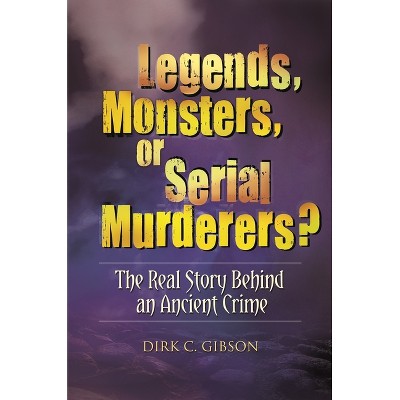Sponsored

Clues from Killers - by Dirk C Gibson (Hardcover)
In Stock
Sponsored
About this item
Highlights
- Serial killers come from different backgrounds, attain different levels of education, and hold various types of jobs.
- About the Author: DIRK C. GIBSON is Associate Professor of Communication and Journalism at the University of New Mexico.
- 264 Pages
- Social Science, Criminology
Description
About the Book
Serial killers come from different backgrounds, attain different levels of education, and hold various types of jobs. However, many serial killers do have at least one thing in common: the desire to communicate regarding their crimes. Killers from Jack the Ripper to the Son of Sam often provide clues to their identities, their motives--even their future targets--through crime scene notes, letters to the media, calls to police, messages scrawled on victims, and, increasingly, email and other technology. Here, Gibson takes a look at ten notorious serial killers, their crimes, their victims, and their communications to uncover the hidden clues into the minds of these unusual and dangerous people.
What compels a serial killer to leave a crime scene message or to call the police to discuss their crimes? What are the purposes of the messages themselves? What do they say about the individuals? How can investigators use such communications to track down these elusive killers? How do killers use these communications to attract new victims? Through a careful examination of messages from such killers as the D.C. Snipers, the BTK Killer, the Zodiac Killer, Jack the Ripper, the Black Dahlia Avenger and others, Gibson reveals aspects of their communications that give us a window into the psyches of these criminals.
Book Synopsis
Serial killers come from different backgrounds, attain different levels of education, and hold various types of jobs. However, many serial killers do have at least one thing in common: the desire to communicate regarding their crimes. Killers from Jack the Ripper to the Son of Sam often provide clues to their identities, their motives--even their future targets--through crime scene notes, letters to the media, calls to police, messages scrawled on victims, and, increasingly, email and other technology. Here, Gibson takes a look at ten notorious serial killers, their crimes, their victims, and their communications to uncover the hidden clues into the minds of these unusual and dangerous people.
What compels a serial killer to leave a crime scene message or to call the police to discuss their crimes? What are the purposes of the messages themselves? What do they say about the individuals? How can investigators use such communications to track down these elusive killers? How do killers use these communications to attract new victims? Through a careful examination of messages from such killers as the D.C. Snipers, the BTK Killer, the Zodiac Killer, Jack the Ripper, the Black Dahlia Avenger and others, Gibson reveals aspects of their communications that give us a window into the psyches of these criminals.Review Quotes
"This book provides audiences with an extensive amount of information.... Gibson's book allows all readers to understand and appreciate the complexity of this topic. It is an excellent introduction to the subject."-Deborah L. Laufersweiler-Dwyer, Associate Professor of Criminal Justice University of Arkansas, Little Rock
"Gibson organizes his book one case at a time, describing the criminals, crimes, victims, investigations, community, reactions, and the role of communication, including rhetoric, journalism, and public relations, in all aspects of these events. The book is clearly written and efficiently organized so that anyone interested just in public relations techniques, for example, can find that information quickly. Taken together, his case studies point to the troubling downside of mass press coverage of these horrific crimes. "Media circuses," he argues, have hindered investigations, harmed victims families, and created panic....[G]ibson's case studies, and, in particular, his conclusions and recommendations could inspire a lively debate among both journalism and public relations students about the role of media in these high-profile crimes and investigations."-Journalism History
?Does the author achieve the 'primary purpose' of his book - to enhance our understanding of serial killers? In my view he does, by giving the reader an insight into the mindset of the various, individual serial killers that are studied in this interesting and informative book.?-Internet Law Book Reviews
?Gibson organizes his book one case at a time, describing the criminals, crimes, victims, investigations, community, reactions, and the role of communication, including rhetoric, journalism, and public relations, in all aspects of these events. The book is clearly written and efficiently organized so that anyone interested just in public relations techniques, for example, can find that information quickly. Taken together, his case studies point to the troubling downside of mass press coverage of these horrific crimes. "Media circuses," he argues, have hindered investigations, harmed victims families, and created panic....[G]ibson's case studies, and, in particular, his conclusions and recommendations could inspire a lively debate among both journalism and public relations students about the role of media in these high-profile crimes and investigations.?-Journalism History
"Does the author achieve the 'primary purpose' of his book - to enhance our understanding of serial killers? In my view he does, by giving the reader an insight into the mindset of the various, individual serial killers that are studied in this interesting and informative book."-Internet Law Book Reviews
About the Author
DIRK C. GIBSON is Associate Professor of Communication and Journalism at the University of New Mexico. He has published numerous articles on a variety of topics in such journals as Public Relations Quarterly, Public Relations Review, and Southern Communication Journal. He has also published several book chapters and one book, The Role of Communication in the Practice of Law (1991).










